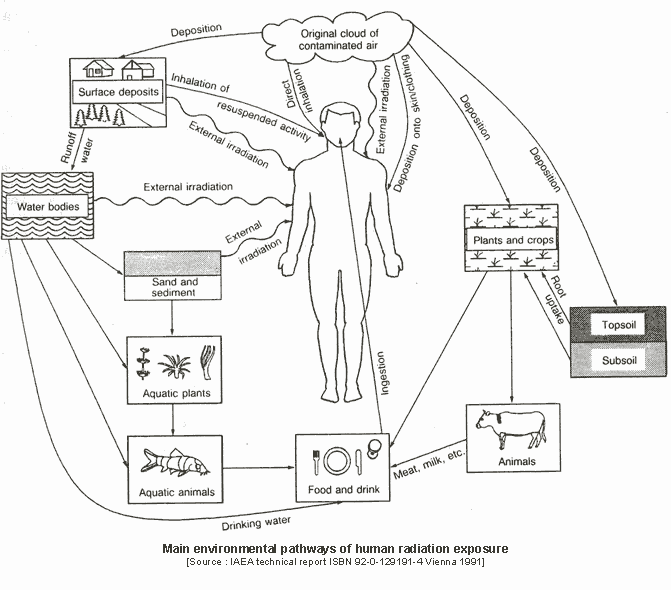Last Updated on April 26, 2024 by Ecologica Life
Chernobyl is a city in Ukraine located just 90 kilometres north of Kyiv. It is well known for the nuclear accident that happened in 1986, where a cooling system of one of the nuclear reactors failed, leading to an explosion and a leak of a huge amount of radiation into the surrounding area, causing a huge loss of life and devastating effects that are still apparent today. In this article we will explore what happened, why it happened, the impact it had and what Chernobyl is like today.
What happened in the Chernobyl incident of 1986?
On April 26 of 1986 the reactor crew were running tests on Chernobyl unit reactor 4. The reactor was designed poorly from the point of view of safety. Additionally, the reactors crew were not following the correct safety protocols, even though they were completely unaware of what was about to follow.
At around 1:24 AM, two explosions occurred in the plant, one followed directly by another. One worker was killed directly in the explosion and another died from explosion related injuries a few hours later.
Smoke, radioactive fission products, and debris from the reactor core soared up to a height of 1km into the air. A number of fires had erupted at the power plant, and the destroyed core was exposed to the atmosphere. Over 100 firemen were called to the scene. Helicopters were called to drop material on the site, 400 individuals worked tirelessly to contruct a tunnel to install a concrete slab to contain the radiation at the site.
By the end of July, 22 plant employees and six firemen died from acute radiation poisoning as a result of the disaster. The acute effects of radiation sickness include fever, nausea and vomiting, diarrhoea and even seizures and coma. The duration of this severe illness stage can range from a few hours to several months.
Large amounts of radioactive materials were released into the air for nearly 10 days as a result of the disaster. This was the largest uncontrolled radioactive leak into the environment ever documented for any civilian operation. Thousands may have gotten radiation sickness if drastic measures were not taken.
The day after the explosion, on April 27th, the town of Pripyat, which operated the plant, was evacuated (some 45,000 residents). By May 14th, around 116,000 residents inside a 30 km radius had been evacuated and later relocated. In the years that followed the incident, an additional 220,000 people were relocated to less contaminated areas.
Long-term health consequences of the Chernobyl incident

It was initially thought that the Chernobyl incident would lead to a huge increase in cancer rates and birth defects. The World Health Organisation (WHO) first voiced concerns in 1989 that local medical scientists had mistakenly linked radiation exposure to a number of unrelated biological and health problems. The Chernobyl Forum, established by the International Atomic Energy Agency (IAEA) and working with the united nations and WHO were commissioned with revising and approving reports prepared about the incident. Their conclusions were:
Apart from this [thyroid cancer] increase, there is no evidence of a major public health impact attributable to radiation exposure 14 years after the accident. There is no scientific evidence of increases in overall cancer incidence or mortality in non-malignant disorders that could be related to radiation exposure
Chernobyl’s Legacy: Health, Environmental and Socio-Economic Impacts and Recommendations to the Governments of Belarus, the Russian Federation and Ukraine, The Chernobyl Forum: 2003–2005, Second revised version
The report estimated that over the years 1991-2015, 20,000 cases of thyroid cancer were diagnosed and 5000 were “probably” due to high radiation intake but the margin for uncertainty was quite high. Thyroid cancer is not typically fatal if diagnosed and treated early. Of all these cases only 15 proved to be fatal.
What may have been more devastating was the psychological damage caused by the incident. A great many individuals believed they were doomed to die from cancer and turned to alcohol and substance abuse.
What is even more shockingly unfortunate is the number of abortions that happened during this time, due to misconceptions from doctors that babies may be born deformed, even though the radiation levels were greatly below those likely to cause deformities. It has been estimated that, due to this misconception, 1 million abortions took place within the Soviet Union and Europe following the Chernobyl incident.
What does the Chernobyl environment look like?
Forests
The half-life of radioactive material is the time taken for half the amount of material initially present to decay. Because many of the most significant radioisotopes have short half-lives, ranging from hours to days, most radioisotopes have long since decayed away. Caesium-137 will be the most significant contaminant for several decades, followed by strontium-90. At low concentrations, plutonium and its decay products, particularly americium-241, will stay in the environment for hundreds to thousands of years.
The highest observed caesium-137 levels have been discovered in forest food products. Following the incident, vegetation and animals in forest and mountain locations have demonstrated exceptionally high radioactive caesium uptake. This is due to the persisent recycling of radioactive caesium particularly in forest ecosystems.
Water
High radioactivity in drinking water from the Kyiv reservoir were a particular concern in the early days following the incident.
Radioactivity levels in water bodies dropped rapidly during the weeks following the fallout due to dilution, physical decay and radioactive absorption into catchment soils. Radioactivity has a significant long-term sink in bed sediments.
While the levels of caesium-137 and strontium-90 in the water and fish of rivers, open lakes, and reservoirs are currently low, the water and fish in some “closed” lakes in Belarus, Russia and Ukraine without outflowing streams will continue to be contaminated with caesium-137 for decades to come.
Plants and animals
Inside the 30 km exclusion zone radiation induced cell death has lead to the following:
- Higher mortality of coniferous plants, soil invertebrates and mammals
- Reproductive losses in plants and animals
Genetic mutations have been observed in plants and animals living in the Chernobyl area, however they generally look the same as their non-mutant counterparts. Research is still ongoing to understand how these genetic changes affect the survival of these creatures. Ironically, due to lack of human activity in the exclusion zone, the exclusion zone has seen a boom in wildlife activity and has become a sanctuary for biodiversity unlike any other.

What is the current situation at Chernobyl like today?
Russian forces seized control of all Chernobyl nuclear facilities on February 24, 2022. Gamma radiation levels were elevated. This was likely due to “disturbance of the top layer of soil from movement of a large number of heavy military machinery through the exclusion zone and increase of air pollution”. The IAEA determined that the site’s radiation readings were low and in line with near background levels.
Until the recent Russian occupation, Chernobyl and the adjacent city Pripyat were devoid of human life. The nuclear power plant and town serve as a stark reminder about the importance of health and safety, and the dangers posed to humanity if we do not handle technologies like nuclear power with the utmost responsibility and care.
Let us hope that humanity can keep this in mind when handling nuclear weapons, dealing with climate change. Time will tell if humanity is yet mature enough to ensure the survival of it and its cohabitants on this planet.








